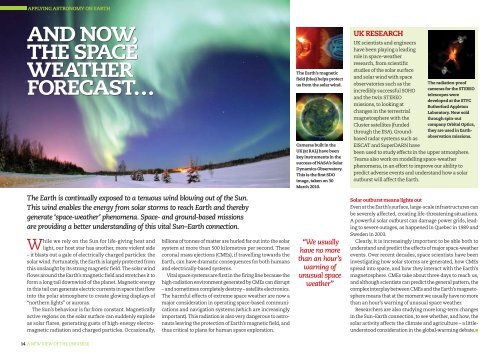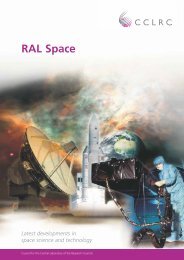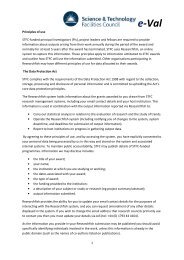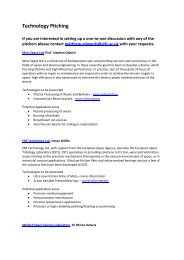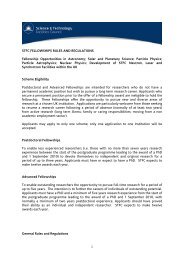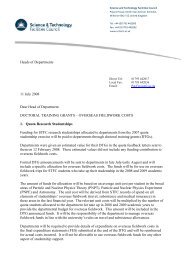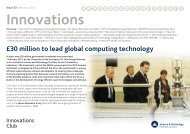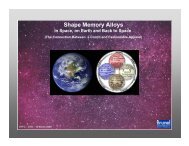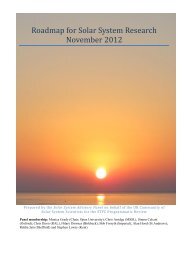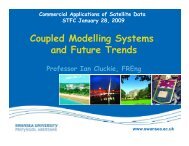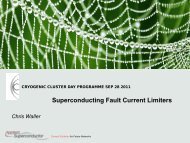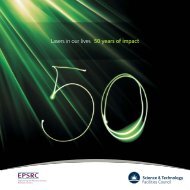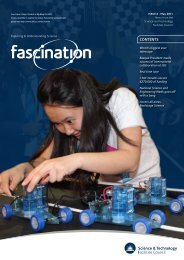A new view of the Universe - Science & Technology Facilities Council
A new view of the Universe - Science & Technology Facilities Council
A new view of the Universe - Science & Technology Facilities Council
You also want an ePaper? Increase the reach of your titles
YUMPU automatically turns print PDFs into web optimized ePapers that Google loves.
APPLYING ASTRONOMY ON EARTH<br />
AND NOW,<br />
THE SPACE<br />
WEATHER<br />
FORECAST…<br />
The Earth is continually exposed to a tenuous wind blowing out <strong>of</strong> <strong>the</strong> Sun.<br />
This wind enables <strong>the</strong> energy from solar storms to reach Earth and <strong>the</strong>reby<br />
generate ‘space-wea<strong>the</strong>r’ phenomena. Space- and ground-based missions<br />
are providing a better understanding <strong>of</strong> this vital Sun–Earth connection.<br />
While we rely on <strong>the</strong> Sun for life-giving heat and<br />
light, our host star has ano<strong>the</strong>r, more violent side<br />
– it blasts out a gale <strong>of</strong> electrically charged particles: <strong>the</strong><br />
solar wind. Fortunately, <strong>the</strong> Earth is largely protected from<br />
this onslaught by its strong magnetic field. The solar wind<br />
flows around <strong>the</strong> Earth’s magnetic field and stretches it to<br />
form a long tail downwind <strong>of</strong> <strong>the</strong> planet. Magnetic energy<br />
in this tail can generate electric currents in space that flow<br />
into <strong>the</strong> polar atmosphere to create glowing displays <strong>of</strong><br />
“nor<strong>the</strong>rn lights” or auroras.<br />
The Sun’s behaviour is far from constant. Magnetically<br />
active regions on <strong>the</strong> solar surface can suddenly explode<br />
as solar flares, generating gusts <strong>of</strong> high-energy electromagnetic<br />
radiation and charged particles. Occasionally,<br />
billions <strong>of</strong> tonnes <strong>of</strong> matter are hurled far out into <strong>the</strong> solar<br />
system at more than 500 kilometres per second. These<br />
coronal mass ejections (CMEs), if travelling towards <strong>the</strong><br />
Earth, can have dramatic consequences for both humans<br />
and electrically-based systems.<br />
Vital space systems are first in <strong>the</strong> firing line because <strong>the</strong><br />
high-radiation environment generated by CMEs can disrupt<br />
– and sometimes completely destroy – satellite electronics.<br />
The harmful effects <strong>of</strong> extreme space wea<strong>the</strong>r are now a<br />
major consideration in operating space-based communications<br />
and navigation systems (which are increasingly<br />
important). This radiation is also very dangerous to astronauts<br />
leaving <strong>the</strong> protection <strong>of</strong> Earth’s magnetic field, and<br />
thus critical to plans for human space exploration.<br />
The Earth’s magnetic<br />
field (blue) helps protect<br />
us from <strong>the</strong> solar wind.<br />
Cameras built in <strong>the</strong><br />
UK (at RAL) have been<br />
key instruments in <strong>the</strong><br />
success <strong>of</strong> NASA’s Solar<br />
Dynamics Observatory.<br />
This is <strong>the</strong> first SDO<br />
image, taken on 30<br />
March 2010.<br />
“We usually<br />
have no more<br />
than an hour’s<br />
warning <strong>of</strong><br />
unusual space<br />
wea<strong>the</strong>r”<br />
UK RESEARCH<br />
UK scientists and engineers<br />
have been playing a leading<br />
role in space-wea<strong>the</strong>r<br />
research, from scientific<br />
studies <strong>of</strong> <strong>the</strong> solar surface<br />
and solar wind with space<br />
observatories such as <strong>the</strong><br />
incredibly successful SOHO<br />
and <strong>the</strong> twin STEREO<br />
missions, to looking at<br />
changes in <strong>the</strong> terrestrial<br />
magnetosphere with <strong>the</strong><br />
Cluster satellites (funded<br />
through <strong>the</strong> ESA). Groundbased<br />
radar systems such as<br />
EISCAT and SuperDARN have<br />
The radiation-pro<strong>of</strong><br />
cameras for <strong>the</strong> STEREO<br />
telescopes were<br />
developed at <strong>the</strong> STFC<br />
Ru<strong>the</strong>rford Appleton<br />
Laboratory. Now sold<br />
through spin-out<br />
company Orbital Optics,<br />
<strong>the</strong>y are used in Earthobservation<br />
missions.<br />
been used to study effects in <strong>the</strong> upper atmosphere.<br />
Teams also work on modelling space-wea<strong>the</strong>r<br />
phenomena, in an effort to improve our ability to<br />
predict adverse events and understand how a solar<br />
outburst will affect <strong>the</strong> Earth.<br />
Solar outburst means lights out<br />
Even at <strong>the</strong> Earth’s surface, large-scale infrastructures can<br />
be severely affected, creating life-threatening situations.<br />
A powerful solar outburst can damage power grids, leading<br />
to severe outages, as happened in Quebec in 1989 and<br />
Sweden in 2003.<br />
Clearly, it is increasingly important to be able both to<br />
understand and predict <strong>the</strong> effects <strong>of</strong> major space-wea<strong>the</strong>r<br />
events. Over recent decades, space scientists have been<br />
investigating how solar storms are generated, how CMEs<br />
spread into space, and how <strong>the</strong>y interact with <strong>the</strong> Earth’s<br />
magnetosphere. CMEs take about three days to reach us,<br />
and although scientists can predict <strong>the</strong> general pattern, <strong>the</strong><br />
complex interplay between CMEs and <strong>the</strong> Earth’s magnetosphere<br />
means that at <strong>the</strong> moment we usually have no more<br />
than an hour’s warning <strong>of</strong> unusual space wea<strong>the</strong>r.<br />
Researchers are also studying more long-term changes<br />
in <strong>the</strong> Sun–Earth connection, to see whe<strong>the</strong>r, and how, <strong>the</strong><br />
solar activity affects <strong>the</strong> climate and agriculture – a littleunderstood<br />
consideration in <strong>the</strong> global-warming debate. ■<br />
14 A NEW VIEW OF THE UNIVERSE


